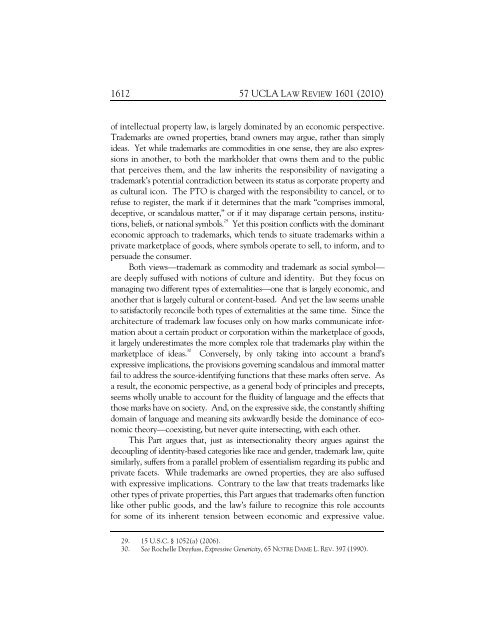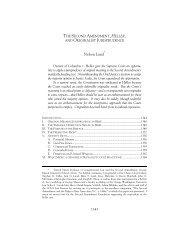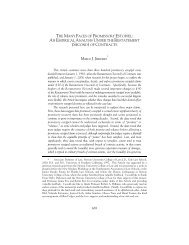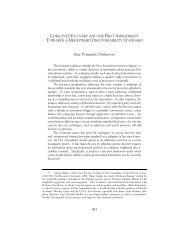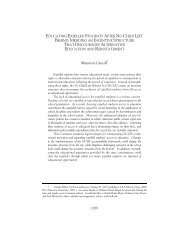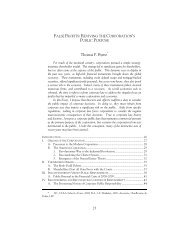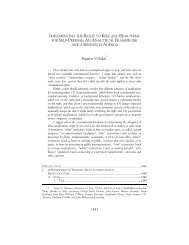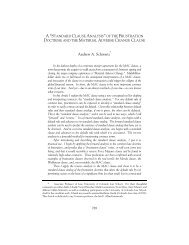Sonia K. Katyal - UCLA Law Review
Sonia K. Katyal - UCLA Law Review
Sonia K. Katyal - UCLA Law Review
You also want an ePaper? Increase the reach of your titles
YUMPU automatically turns print PDFs into web optimized ePapers that Google loves.
1612 57 <strong>UCLA</strong> LAW REVIEW 1601 (2010)<br />
of intellectual property law, is largely dominated by an economic perspective.<br />
Trademarks are owned properties, brand owners may argue, rather than simply<br />
ideas. Yet while trademarks are commodities in one sense, they are also expressions<br />
in another, to both the markholder that owns them and to the public<br />
that perceives them, and the law inherits the responsibility of navigating a<br />
trademark’s potential contradiction between its status as corporate property and<br />
as cultural icon. The PTO is charged with the responsibility to cancel, or to<br />
refuse to register, the mark if it determines that the mark “comprises immoral,<br />
deceptive, or scandalous matter,” or if it may disparage certain persons, institutions,<br />
beliefs, or national symbols. 29<br />
Yet this position conflicts with the dominant<br />
economic approach to trademarks, which tends to situate trademarks within a<br />
private marketplace of goods, where symbols operate to sell, to inform, and to<br />
persuade the consumer.<br />
Both views—trademark as commodity and trademark as social symbol—<br />
are deeply suffused with notions of culture and identity. But they focus on<br />
managing two different types of externalities—one that is largely economic, and<br />
another that is largely cultural or content-based. And yet the law seems unable<br />
to satisfactorily reconcile both types of externalities at the same time. Since the<br />
architecture of trademark law focuses only on how marks communicate information<br />
about a certain product or corporation within the marketplace of goods,<br />
it largely underestimates the more complex role that trademarks play within the<br />
marketplace of ideas. 30<br />
Conversely, by only taking into account a brand’s<br />
expressive implications, the provisions governing scandalous and immoral matter<br />
fail to address the source-identifying functions that these marks often serve. As<br />
a result, the economic perspective, as a general body of principles and precepts,<br />
seems wholly unable to account for the fluidity of language and the effects that<br />
those marks have on society. And, on the expressive side, the constantly shifting<br />
domain of language and meaning sits awkwardly beside the dominance of economic<br />
theory—coexisting, but never quite intersecting, with each other.<br />
This Part argues that, just as intersectionality theory argues against the<br />
decoupling of identity-based categories like race and gender, trademark law, quite<br />
similarly, suffers from a parallel problem of essentialism regarding its public and<br />
private facets. While trademarks are owned properties, they are also suffused<br />
with expressive implications. Contrary to the law that treats trademarks like<br />
other types of private properties, this Part argues that trademarks often function<br />
like other public goods, and the law’s failure to recognize this role accounts<br />
for some of its inherent tension between economic and expressive value.<br />
29. 15 U.S.C. § 1052(a) (2006).<br />
30. See Rochelle Dreyfuss, Expressive Genericity, 65 NOTRE DAME L. REV. 397 (1990).


